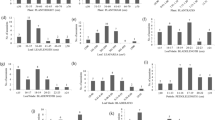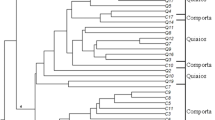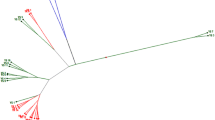Abstract
Cultivated rocket (Eruca vesicaria) is a leafy vegetable highly appreciated for its health-promoting virtues and consumed both raw and cooked as ready-to-use vegetable. Despite Eruca being cultivated worldwide, only a few cultivars are available and limited breeding activities have been carried out so far. Therefore, the genetic resources available represent an unexploited potential source of variation for breeding. In the present study, 155 E. vesicaria accessions from 30 countries across Europe, Asia, Africa, and America have been characterized for 54 qualitative and quantitative morphological and quality traits. Conventional descriptors and automated tools for the determination of the quality, morphology, and colour of leaves have been used. Genetic diversity was assessed using 15 inter simple sequence repeat and simple sequence repeat markers. A high level of diversity was evidenced in the collection. Significant differences were found in most of the traits with the exception of five pseudo-qualitative descriptors. The first and second dimensions of the principal components analysis with phenotypic traits accounted for 25.69% of total variation showing a stratification of the genotypes according to the European and Asian origins. In total, 75% of the variation was contained in the first 15 components having eigenvalues higher than 1.0. Also, the population structure divided the collection into two main clusters separating European genotypes from the rest. Furthermore, hierarchical cluster analysis confirmed a geographical separation, grouping the accessions into three major clusters, which were differentiated by plant architecture, leaf and flower colour, leaf water status, leaf blade shape and hairiness of the leaves and stem. Our approach has broadened the knowledge of the diversity within the Eruca gene pool, thus contributing to identify sources of variation and to select the best candidates for cultivated rocket breeding programs, as well as to determine the genetic basis of plant and leaf traits in future genome-wide association studies.






Similar content being viewed by others
References
Andrey P, Maurin Y (2005) Free-D: an integrated environment for three-dimensional reconstruction from serial sections. J Neurosci Methods 145:233–244
Awada L, Phillips PWB, Smyth SJ (2018) The adoption of automated phenotyping by plant breeders. Euphytica 214:148. https://doi.org/10.1007/s10681-018-2226-z
Barrs HD, Weatherley PE (1962) A re-examination of the relative turgidity technique for estimating water deficits in leaves. Aust J Biol Sci 15(3):413–428
Bell L, Wagstaff C (2014) Glucosinolates, myrosinase hydrolysis products, and flavonols found in rocket (Eruca sativa and Diplotaxis tenuifolia). J Agric Food Chem 62:4481–4492
Bell L, Oruna Concha MJ, Wagstaff C (2015) Identification and quantification of glucosinolate and flavonol compounds in rocket salad (Eruca sativa, Eruca vesicaria and Diplotaxis tenuifolia) by LC-MS: highlighting the potential for improving nutritional value of rocket crops. Food Chem 172:852–861
Bell L, Methven L, Wagstaff C (2017) The influence of phytochemical composition and resulting sensory attributes on preference for salad rocket (Eruca sativa) accessions by consumers of varying TAS2R38 diplotype. Food Chem 222:6–17
Bennett RN, Mellon FA, Botting NP, Eagles J, Rosa EAS, Williamson G (2002) Identification of the major glucosinolate (4-mercaptobutyl glucosinolate) in leaves of Eruca sativa L. (salad rocket). Phytochemistry 61:25–30
Bozokalfa MK, Eşiyok D, Ilbi H, Kaygisiz AT (2010) Estimates of genetic variability and association studies in quantitative plant traits of Eruca spp. landraces. Genetika 42(3):501–512
Bozokalfa MK, Eşiyok D, Ilbi H, Kavak S, Kaygisiz AT (2011) Evaluation of phenotypic diversity and geographical variation of cultivated (Eruca sativa L.) and wild (Diplotaxis tenuifolia L.) rocket plant. Plant Genet Resour C 9:454–563
CBI Centre for the Promotion of Imports from developing countries (2019) https://www.cbi.eu/market-information/fresh-fruit-vegetables/fresh-herbs/europe/. Accessed 21 Sept 2019
Cheruiyot EK, Mumera LM, Ngetich WK, Hassanali A, Wachira F (2007) Polyhenols as potential indicators for osmotic tolerance in tea (Camellia sinensis L.). Biosci Biotechnol Biochem 71:2190–2197. https://doi.org/10.1271/bbb.70156
Curtin F, Schulz P (1998) Multiple correlations and Bonferroni’s correction. Biol Psychiatr 44:775–777
D’Antuono LF, Elementi S, Neri R (2008) Glucosinolates in Diplotaxis and Eruca leaves: diversity, taxonomic relations and applied aspects. Phytochemistry 69:187–199
Daayf F, El Hadrami A, El-Bebany AE, Henriquez MA, Yao Z, Derksen H, El-Hadrami I, Adam LR (2012) Phenolic compounds in plant defense and pathogen counter-defense mechanisms. Rec Adv Polyphen Res 3:191–208
Dalin P, Agren J, Björkman C, Huttumen P, Kärkkäinen K (2008) Leaf trichome formation and plant resistance to herbivory. In: Schaller A (ed) Induced plant resistance to herbivory. Springer, Berlin, pp 89–105
Earl DA, vonHoldt BM (2012) STRUCTURE HARVESTER: a website and program for visualizing STRUCTURE output and implementing the Evanno method. Conserv Genet Resour 4:359–361
Egea-Gilabert C, Fernandez JA, Migliaro D, Martinez Sanchez JJ, Vicente MJ (2009) Genetic variability in wild vs. cultivated Eruca vesicaria populations as assessed by morphological, agronomical and molecular analyses. Sci Hortic 121:260–266
Fine PVA (2015) Ecological and evolutionary drivers of geographic variation in species diversity. Annu Rev Ecol Evol Syst 46:369–392. https://doi.org/10.1146/annurev-ecolsys-112414-054102
Gilardi G, Chen G, Garibaldi A, Zhiping C, Gullino ML (2007) Resistance of different rocket cultivars to wilt caused by strains of Fusarium oxysporum under artificial inoculation conditions. J Plant Pathol 89:113–117
Gómez-Campo C (2003) Morphological characterization of Eruca vesicaria (Cruciferae) germplasm. Bocconea 16:615–624
Guijarro-Real C, Prohens J, Rodriguez-Burruezo A, Adalid-Martínez AM, López-Gresa MP, Fita A (2019) Wild edible fool’s watercress: a potential crop with high nutraceutical properties. PeerJ 7:e6296
Hall MKD, Jobling JJ, Rogers GS (2012) Some perspectives on rocket as a vegetable crop: a review. Veg Crop Res Bull 76:21–41
Hanldey R, Ekbom B, Ågren J (2005) Variation in trichome density and resistance against a specialist insect herbivore in natural populations of Arabidopsis thaliana. Ecol Entomol 30:284–292
Hauser MT (2014) Molecular basis of natural variation and environmental control of trichome patterning. Front Plant Sci 5:320
Higdon JV, Delage B, Williams DE, Dashwood RH (2007) Cruciferous vegetables and human cancer risk: epidemiologic evidence and mechanistic basis. Pharmacol Res 55:224–236
IPGRI (1999) Descriptors for rocket (Eruca spp.). International Plant Genetic Resources Institute, Rome
Lenzi A, Tesi R (2000) Effect of some cultural factors on nitrate accumulation in rocket [Diplotaxis tenuifolia (L.) D.C. – Eruca sativa Mill.]. Riv Agronomia 34(4):419–424
Mantel NA (1967) The detection of disease clustering and a generalized regression approach. Cancer Res 27:209–220
Meyer RS, Purugganan MD (2013) Evolution of crop species: genetics of domestication and diversification. Nat Rev Genet 14:840–852
Ninfali P, Mea G, Giorgini S, Rocchi M, Bacchiocca M (2005) Antioxidant capacity of vegetables spices and dressings relevant to nutrition. Br J Nutr 93:257–266
Padulosi S, Pignone D (1996) Rocket: a mediterranean crop for the world. Report of a workshop. IPGRI International Plant Genetic Resources Institute, Bioversity International, Rome, p 101
Pane C, Sigillo L, Caputo M, Serratore G, Zaccardelli M, Tripodi P (2017) Response of rocket salad germplasm (Eruca and Diplotaxis spp.) to major pathogens causing damping-off, wilting and leaf spot diseases. Arch Phytopathol Plant Protect 50:167–177
Pariyar S, Eichert T, Goldbach HE, Hunsche M, Burkhardt J (2013) The exclusion of ambient aerosols changes the water relations of sunflower (Helianthus annuus) and bean (Vicia vaba) plants. Environ Exp Bot 88:43–52
Pasini F, Verardo V, Caboni MF, D’Antuono LF (2012) Determination of glucosinolates and phenolic compounds in rocket salad by HPLC-DAD−MS: evaluation of Eruca sativa Mill. and Diplotaxis tenuifolia L. genetic resources. Food Chem 133:1025–1033
Powell W, Morgante M, Andre C, Hanafey M, Vogel J, Tingey S, Rafalski A (1996) The utility of RFLP, RAPD, AFLP and SSR (microsatellite) markers for germplasm analysis. Mol Breed 2:225–238
Prevost A, Wilkinson MJ (1999) A new system of comparing PCR primers applied to ISSR fingerprinting of potato cultivars. Theor Appl Genet 98:107–112
Pritchard JK, Stephens M, Donnelly P (2000) Inference of population structure using multilocus genotype data. Genetics 155:945–959
Singleton VL, Rossi JA Jr (1965) Colorimetry of total phenolics with phosphomolybdic-phosphotungstic acid reagents. Am J Enol Viticult 16:144–158
Taiz L, Zeiger E (2006) Plant physiology, 4th edn. Sinauer Associates Inc., Sunderland
Tanentzap FM, Stempel A, Ryser P (2015) Reliability of leaf relative water content (RWC) measurements after storage: consequences for in situ measurements. Botany 93:535–541
Taranto F, Francese G, Di Dato F, D’Alessandro A, Greco B, Onofaro Sanajà V, Pentangelo A, Mennella G, Tripodi P (2016) Leaf metabolic, genetic, and morphophysiological profiles of cultivated and wild rocket salad (Eruca and Diplotaxis spp.). J Agric Food Chem 64:5824–5836
Thakur AK, Singh KH, Singh L, Nanjundan J, Khan YJ, Singh D (2018) SSR marker variations in Brassica species provide insight into the origin and evolution of Brassica amphidiploids. Hereditas 155:6. https://doi.org/10.1186/s41065-017-0041-5
The Plant List (2019). http://www.theplantlist.org/tpl1.1/search?q=Eruca. Accessed 21 Sept 2019
Tripodi P, Francese G, Mennella G (2017) Rocket salad: crop description, bioactive compounds and breeding perspectives. Adv Hortic Sci. https://doi.org/10.13128/ahs-21087
Vavilov NI (1926) Centers of origin of cultivated plants. Bull Appl Bot Genet Plant Breed 16:1–248
Wagner GJ (1991) Secreting glandular trichomes: more than just hairs. Plant Physiol 96:675–679
Warwick SI, Gukel RK, Gomez-Campo C, James T (2007) Genetic variation in Eruca vesicaria (L.) Cav. Plant Genet Resour C 5:142–153
Acknowledgements
The work was supported by ‘RGV-FAO’ project funded by the Italian Ministry of Agriculture, Food and Forestry. C. Guijarro-Real thanks the Ministerio de Educación, Cultura y Deporte of Spain (MECD) for its financial support by means of a predoctoral FPU Grant (FPU14/06798), and for the specific grant for mobility (EST17/00354) from the same Organization.
Author information
Authors and Affiliations
Corresponding author
Ethics declarations
Conflict of interest
The authors declare that they have no conflict of interest.
Additional information
Publisher's Note
Springer Nature remains neutral with regard to jurisdictional claims in published maps and institutional affiliations.
Electronic supplementary material
Below is the link to the electronic supplementary material.
Rights and permissions
About this article
Cite this article
Guijarro-Real, C., Navarro, A., Esposito, S. et al. Large scale phenotyping and molecular analysis in a germplasm collection of rocket salad (Eruca vesicaria) reveal a differentiation of the gene pool by geographical origin. Euphytica 216, 53 (2020). https://doi.org/10.1007/s10681-020-02586-x
Received:
Accepted:
Published:
DOI: https://doi.org/10.1007/s10681-020-02586-x




